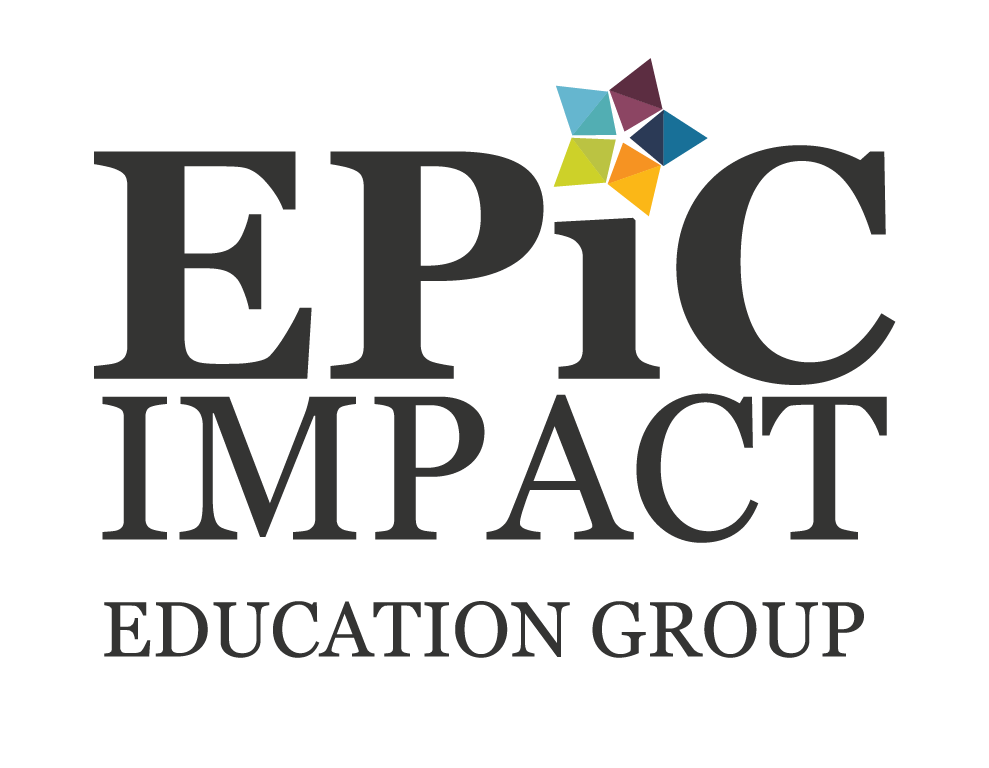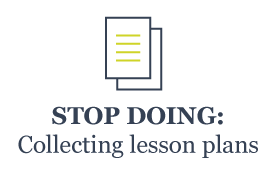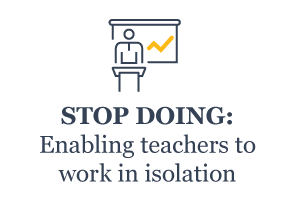Make An Immediate Impact in Your School: 3 Things To Stop Doing Today
Over the last five years, schools have been smothered with initiatives, mandates, and new programs thrown at school leaders, teachers, and schools. Many of these initiatives were developed based on research, good intentions, and strategy, but it has left many educators feeling like they’re drinking water from a fire hose with little time to catch a breath. From my own educational background, research, and current position working with schools across the country, I often worry about the feasibility or even practicality of schools being able to leverage their time, talent, and resources to implement all or any of these new reforms.
School leaders must learn how to filter external influences, prioritize initiatives, eliminate distractions, and maintain an internal laser-like focus on student learning. There comes a time when leaders must spend as much time deciding what things to “stop doing” as they do coming up with new ideas. In fact, a new idea would be to systematically review what practices, strategies, or initiatives are expending valuable resources of time, energy, and money which have little or no impact on student learning. As Jim Collins suggests in his book Good to Great (2002), leaders should start with a “not-to-do list.”
This is what we have learned from conversations with successful school leaders in Ohio and across the country that have stayed ahead of the curve and maintained an environment of student success. Many high-performing buildings and districts have the discipline to stop doing things they have always done. Especially if there is little proof or correlation that the practice aligned with their building/district goals or contributed to desired student outcomes. John Hattie (2009) calls this practice of “knowing thy impact” an important strategy in high-performing schools. The purpose of this article is to explore three things you can stop doing today that will provide the focus and the time to ensure student learning remains the priority in your district.
Schools get stuck in their journey of moving from “good to great” because they have a difficult time shifting their culture and conversations from a focus on teaching to a laser-like focus on student learning. In buildings that struggle or fail to make the jump to high performing, you hear conversations around pacing guides as “racing guides,” “I already taught that,” or, “I have no time to cover the entire curriculum.” First, let me share that pacing guides are an important planning tool for creating common or short-cycle assessments. However, many schools unintentionally allow these guides to pressure teachers to relentlessly cover the entire curriculum regardless of whether students are learning the material or not. Pacing guides should be a tool to plan for when assessments will occur and even have built-in time for re-teaching after students are assessed “for learning.” Teachers should not feel pressure from themselves or school leaders to race through their pacing guides without any regard to whether students are mastering material or not.
To move a culture from focusing on teaching to one that focuses on student learning, principals could start collecting weekly (or twice per month) assessments from their teachers. Developing and turning in daily lesson plans is much more stressful and time consuming for teachers and does not ensure that students mastered material. Instead of collecting lesson plans, school leaders could have their teachers create assessments before teaching a unit of study collaboratively with other teachers of the same subject or department. The practice of developing assessments before designing lessons will have a higher impact of ensuring an aligned curriculum and essential standards will be covered in the classroom than creating the lessons first then the assessment. What teacher would create an assessment and not cover the material that would ensure their students’ success?
After assessing students for learning, school leaders should have teachers record on the front, right-hand corner of each assessment the number and percentage of students who scored an 85 percent or higher. While most teachers consider 80 percent as proficient, we have learned that proficient is not college or career ready. An 85 percent standard is more rigorous and is a very good standard to establish for mastery. More importantly, on the back of every assessment or attached sheet, the teacher should write the names of each student who did not get an 85 percent or higher. This philosophy of “name them and claim them” increases the responsibility for the teacher and principal to know the students’ names who need additional re-teaching and support, instead of just a number or percentage of students who need intervention. If a teacher did not give any assessments during the week, the teacher is still probably using some level of formative assessments. The teacher should still turn in a list with names of students who are not mastering material that week. This allows the principal and teacher to evolve in becoming a learning leader. Time spent focusing on monitoring student learning is time better spent than monitoring teachers’ lesson plans and is a higher leverage strategy for accelerating student learning.
This approach will also encourage and support teachers to develop common or short-cycle assessments that can be collaboratively scored or reviewed as a team to identify students who need additional support or even stretched. Odden and Archibald (2009) discovered that nearly every school that doubled its performance data had implemented common or short-cycle assessments. A common theme from the Ohio Department of Education’s (ODE) Promising Practices Regional Workshops, featuring some of the highest performing districts and buildings across the state, were the use of common assessments and teachers analyzing student learning collaboratively. In addition, the school must have a system in place to respond to students who are not mastering material. It cannot be left up to the classroom teacher alone to respond to struggling students. Many high-performing schools have daily intervention/enrichment (I&E) or no new instruction (NNI) periods built into their daily schedules. During team meetings, teachers make decisions on where students may be assigned during this period so intervention is always timely (students are identified quickly who need additional support), directive (students are assigned to intervention based on need), and systematic (school-wide response instead of the individual teacher). Schools cannot wait until the grading period to learn which students are struggling or need additional support. To ensure that the entire building is aware of struggling students at all times, a strategy as easy as collecting frequent assessments from teachers can help increase the likelihood of all students having success.
When all professionals are required to come out of isolation and work on teams, the impossible is possible. Twenty-three heart surgeons from Maine, New Hampshire, and Vermont demonstrated the success of teamwork when they agreed to observe each other regularly during operations and share best practices. They collaborated and observed each other during a nine-month period. Two years later, research showed that the death rate among their patients fell by an astonishing 25 percent. Their success was attributed to their emphasis on promoting teamwork and communications rather than working in isolation. All doctors brought about major changes in their professional and organizational practices, according to Bob Garmston and Bruce Wellman in their 2009 book, The Adaptive School: A Sourcebook for Developing Collaborative Groups. Many high-performing districts we work with have discovered the importance of creating and developing teacher-based teams, building leadership teams, and a district leadership team, all of which are components of the Ohio Improvement Process (OIP).
Principals still need to develop their skills to provide feedback and coaching to individual teachers. But, why not increase all of your teams’ effectiveness by spending more time with groups of teachers to review data, have conversations about student learning and lessons, and share teaching and intervention strategies? Fullan and Hargreaves (2012) research puts a greater emphases on “social capital” (teams) than “human capital” (individuals). In fact, human capital can be developed through social capital.
A strategy could be that the principal does classroom observations with all of the grade-level teachers during one week. The following week the principal meets with the entire team and explores the types of feedback and questions he or she observed. Was a majority of the feedback at the task, process, or self-regulation level? Were teachers asking deep or surface-level questions? If trust is established, the principal may even capture a few minutes of video of each class and do a lesson study. By taking the time to develop group norms, facilitate collaborative meetings, and learn with a team, the principal communicates the importance of team work. The principal should prioritize these types of meetings in their weekly schedule. In fact, depending on the negotiated contract and teachers observed, the principal could substitute four individual meetings with each teacher for one meeting with all four teachers.
High-performing teams are “multipliers” in a school building. Teams can take on challenges, initiatives, test hypotheses, support struggling teachers, and help the principal become even more effective.
Rick DuFour once joked in a presentation that when Moses came down off of Mount Sinai he had the tablet with the 11 Commandments. The eleventh Commandment was, “thou shall not mess with the school schedule.” For years, principals have built their building’s schedules around lunch, athletics, and transportation. Recently, while facilitating a leadership academy in Mississippi, I asked the participants, “If I were to look at your school schedule, would I be able to identify your priorities?” Not one of the 30 school leaders in attendance answered, “Yes.” Your building schedule should clearly communicate your priorities to students, parents, and especially staff. Every year, we hear concerns from educators that there is not enough time in the day. However, building leaders decide through scheduling how that time is being used.
What are your building’s priorities, goals, and values?
- Improve math and reading scores and growth
- Offer students course work that prepares them for success in high-growth industries
- Make time to address social/emotional growth through an advocacy or advisory program, or even health and wellness activities
- Provide more opportunities for extra-curricular activities or internship or apprenticeship programs
- Structure interventions critical for students who need additional support
- Encourage more students to enroll in rigorous courses/programs (e.g. Advanced Placement, dual enrollment, advanced courses, International Baccalaureate) and provide the structures and support necessary for students to be successful
- Provide daily collaboration and planning time for teachers
- Provide job-embedded professional learning time for staff
- Implement an inclusion model for students with disabilities
No matter your priorities, goals, and values, your school schedule should clearly reflect them. Most school schedules can support four to five goals. It is also important to build the schedule through a collaborative process. It’s not enough just to have more time. It’s important to focus on making better use of time. Some schools have developed schedules to meet the priorities, goals, and values above by:
- Increasing instructional class time for core classes like math and/or reading
- Using blended or on-line learning to free up time in the schedule
- Combining classes like math/science or reading/math
- Moving courses to another grade level or offering courses before or after school or in the summer
- Scheduling all students’ elective courses during the same time to create collaboration time for staff
Regardless of your building’s goals, the high- performing buildings we have worked with always have additional time built in the schedule for 1) intervening with struggling students, and 2) opportunities for teachers to collaborate purposely. This was also reinforced during the ODE’s Promising Practices Workshops as every building and district had created additional time in their schedules to support student learning.
In Summary
Schools can be improved by stopping what we have traditionally done and by focusing on high-impact strategies or practices that may even take less time, talent, and resources. The challenge is not in adopting new practices, but by abandoning old practices.
To create a high-performing school, there are three important things we need to stop doing immediately:
- Stop collecting lesson plans
- Stop allowing teachers to work in isolation
- Stop allowing our schedules to own us
By focusing our time and practices on higher impact strategies and abandoning practices that have little impact on student learning, school leaders and teachers may find themselves with more time on their hands than ever before imagined.
References
Collins, J. (2001). Good to great. New York, NY: HarperCollins Publishers, Inc.
Hargreaves, A. & Fullan, M. (2012). Professional capital: Transforming teaching in every school. New York, NY: Teachers College Press.
Garmston, R. J. & Wellman, B. M. (1999). The adaptive school: A Sourcebook for developing collaborative groups. Norwood, MA: Christopher Gordon Publishers
Hattie, J. (2009). Visible Learning: A Synthesis of Over 800 Meta-Analyses Relating to Achievement. London: Routledge.
Odden, R.A. & Archibald, S.J. (2009). Doubling student performance and finding the resources to do it. Thousand Oaks, CA: Corwin Press.
About the Author Bobby Moore has spent more than 25 years in education as a teacher, principal and superintendent. As President & CEO of EPIC Impact Education Group, he partners with schools and professional associations across the country to implement high-growth strategies, professional learning for leaders, strategies for creating high performing and positive cultures, as well as keynoting at conferences and school districts. Please contact him at Dr.BobbyMooreed@gmail.com or follow him on Twitter @DrBobbyMoore.
This article was published in the 2015 Fall OAESA Principal Navigator
This article was authored by me as an employee of Battelle for Kids.
© 2017, Battelle for Kids. All Rights Reserved
ShareShare Make an Immediate Impact on your School: Three things to stop doing today
- Like Liked UnlikeMake an Immediate Impact on your School: Three things to stop doing today
Like




